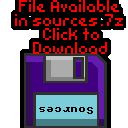

Multiplatform Lessons
 |
The
Random number generator shown today is far from the 'Best'...
but it does work! It's used in these tutorials by all the games as it's been tested without any problems, and has been ported to many different systems and CPUs, and given the same random seed, it gives the same results... meaning it can be used for generating random levels in your game, and the level will be the same on every system. |
Random number generation
| To allow our random number generator to create good varied results, we use a pair of 16 byte lookup tables |  |
| We have two random number generators, The first returns a single byte in R0... using rotations and EOR, using two 8 bit seeds R1/R4 |
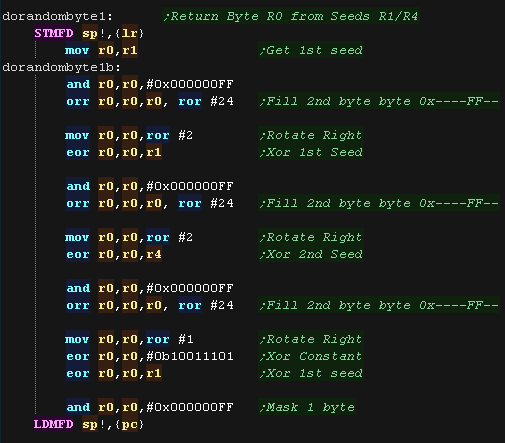 |
| We need the 'Low byte' to be very different, or the 16 bit
values won't be very random! We use the lookup tables to get some new data, and combine these to produce the second value |
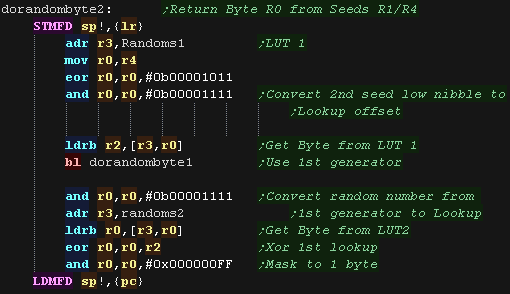 |
| We have two routines we can use to get values "DoRandomWord" will get a 16 bit value R3,R6 from seed R1, this can be used to produce 'psuedorandom' data for times we want repeatable results. "DoRandom" is an easy function to return an 8 bit byte in R0... it automatically updates its seed every time. |
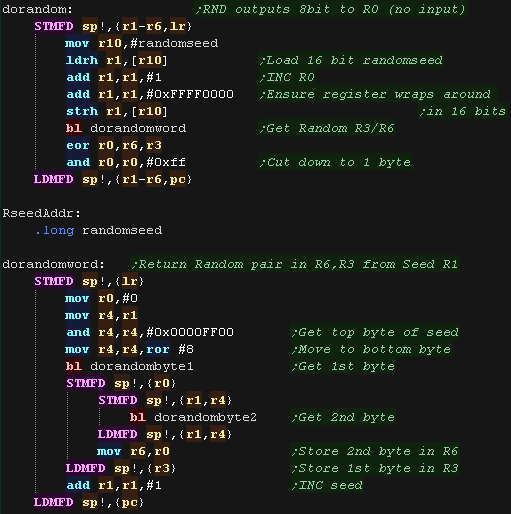 |
| To
be usable, a random number generator needs to produce every
possible random number (0-255 or 0-65535)... otherwise you
could have serious problems with your program (if you're
waiting for a result that never happens). The more 'random' the data the better... that is, if you plotted the values on a graph there should be no patterns present. |
 |
| We need to do 'Collision detection'. We specify a two targets and a 'range' ... if target 1 is within 'Range' of target 2, we return A=1... if it's out of range we return A=0... This means we can do a BNE or BEQ on return. |
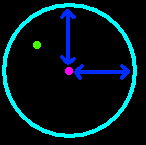 |
The range check is simple... we test X and Y axis We test the X axis first. we subtract the 'RANGE' from each axis of the object, and check if we went below Zero (if so that direction is over the limit)... we then compare to the position... if it's lower we're out of range... if not we need to test more! Next we add 'RANGE' twice... once to move back to the center and once to move to the right... we then compare to the position... If it's higher we're out of range... if not we need to test the Y axis! We repeat the same tests for the Y axis. |
 |
The Battle for BCD
| Converting large numbers from Hex to Ascii is hard! A common simple solution to this is Binary Coded Decimal... This stores a single 0-9 digit in each nibble - Two per byte, This is known as PACKED BCD! This is easier to show to screen than normal hex numbers. |
  |
| BCD only uses a 0-9 value in each nibble... but of course each
nibble can really support 0-F Suppose we repeatedly add 1 to the value 8... we'll need to correct the value once the value goes over 9 values like $0A will need to be converted to the correct BCD value of $10... and we'll need to do that ourselves! |
$08 +1 $09 +1 $0A -> $10 |
| To ShowBCD, we need to step through each of
the 8 digits in our 32 bit value..... here we'll show R1 to the
screen we rotate a digit (nibble) out of R1 into R0, add #48 to convert it to Ascii, and show it to the screen with PrintChar We repeat until all 8 characters are shown. |
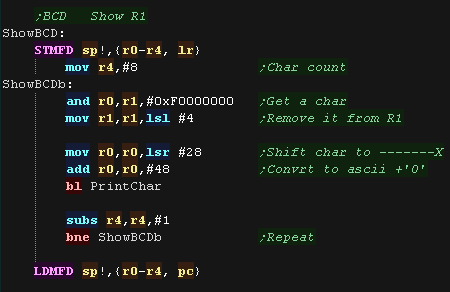 |
We'll need to AddBCD to add score... but this is a little more tricky! Here we're adding our values one digit at a time, but we need to cope with any carry!... If a digit goes over 9, we need to add 6, skipping over the A-F part of the nibble, and storing any carry for the next digit in R6 we repeat for all 8 digits. |
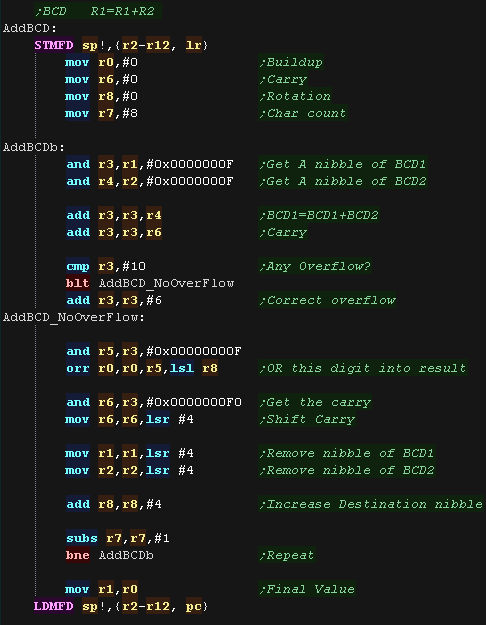 |
| We can write SubBCD to subtract BCD in a
similar way Once again we work through the digits keeping track of the carry. |
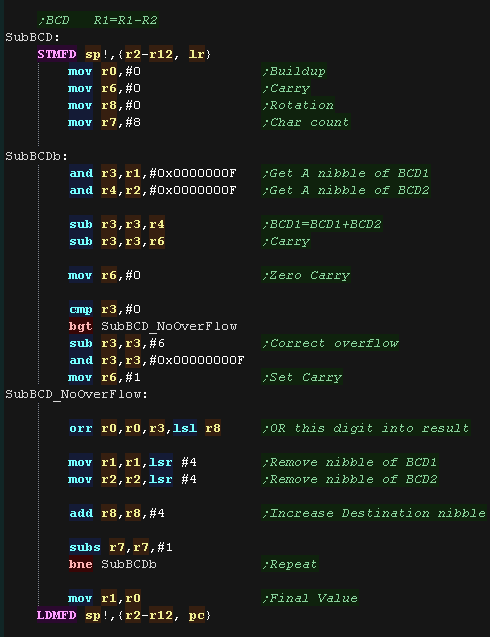 |
 |
We'll also need to compare two BCD values
for our highscore routine, but we don't need any special code to
do this, we can just use the normal CMP to do the job! |
GenericAnimator Introduction
| GenericAnimator performs all the movement animations for the
characters in the ChibiLife demo. Movement and sprite animation is
all done by these GenericAnimator scripts The Collision detections are handled by special code, but the GenericAnimator checks these collision flags are detected, and characters 'Turn round' automatically A pointer to the object to be animated is passed to the animator code, and changes will be made to things like Xpos, Ypos and sprite number etc to 'automatically' animate the object. |
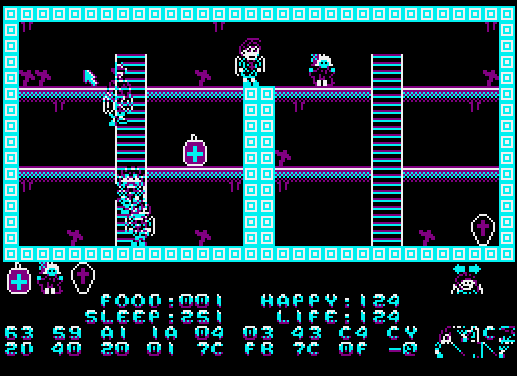 |
| Pointers for the animation scripts are held in a list. The first entry is 'animator 1' as animator 0 is 'no animation' |
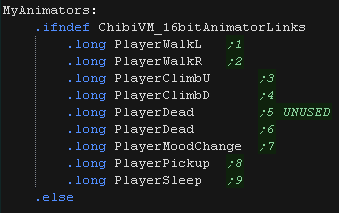 |
| Animation scripts start with a 1 byte 'Tick Mask'. This is ANDed
with the current game tick - if the result is zero, the next step of
the animation will occur. Each line of an animation script is 4 bytes , the first byte is the 'command' the other three are parameters for that command. Note that while a tick normally processes 1 line, it's possible to process extra lines per tick with the 'aEXT' flag. |
 |
Code - Init
| At the start of the script processor we will be
passed An animator number in R1 An animator Frame/Tick in R4 (the line number we will process next in the script) We back these up, then check the animator number - 0 Means no animation in which case we return. We use GetAnimatorMemPos to calculate the address of this script, then load in the first byte of the animation script This first byte is the 'Tick Mask' - it's ANDed with the current game tick, if the result is zero, the animation script processes a line. BUT we can override this, and use a custom tick, according to the value in R3/R6 If the tick should occur this time, we run objectanimator_ProcessTick Which will process a line of the script |
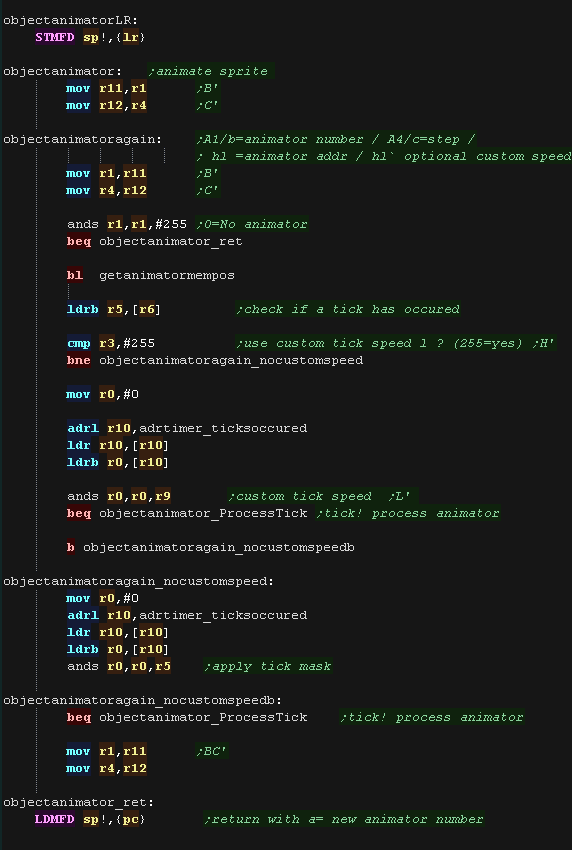 |
| objectanimator_ProcessTick take's
the current script line number and multiplying it by four (as each
line is 4 bytes) We load in the command byte number, the bottom 4 bits are the command (16 commands total MAX) (The top bits are for conditionals and multiline support) we use this to load a pointer in the animator_vectorarray which is the address of the command processor - we call it now |
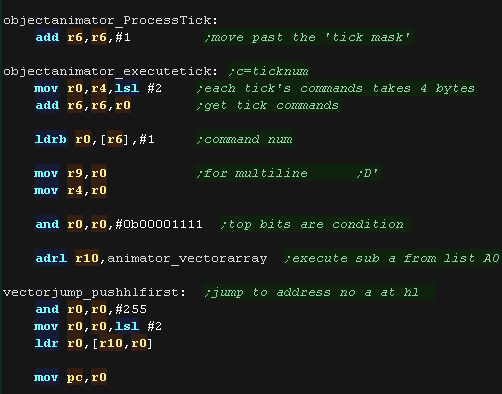 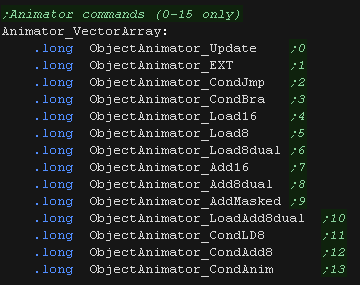 |
Code - Extended Commands
| The first command is a
special one! EXT allows for extended commands. 'Extended commands' use the first parameter byte as a 'command number' - This allows more commands (an extra 255!), but allows only 0-2 parameters (rather than 0-3) We load the command number and use it as an offset to the animator_vectorarrayext list |
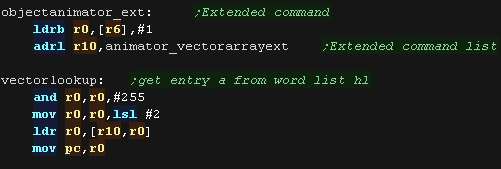 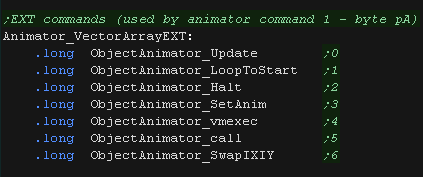 |
| LoopToStart resets the frame/tick number back to 0 |  |
| Halt stops the animation - by setting the
animator number to 0 |
 |
| SetAnim sets the Animator and Frame/line (0=first
frame). |
 |
| vmexec Executes a call within the 'ChibiVM'
virtual machine. The address to call is in 16 bit little endian. |
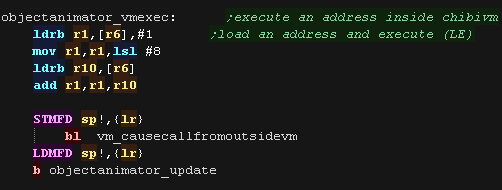 |
| Call runs a call natively on the ARM cpu. As the destination address needs to be 32 bit, we load a 1 byte number from the command parameter, and use it as an offset in a call list |
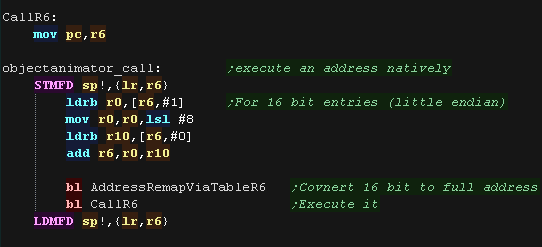 |
| SwapIXIY allows a pointer to an alternate object
to be used (IX and IY were registers on the Z80) This should only be used as part of a multiline sequence! (using aEXT) |
 |
Commands
| condjmp will jump to an alternative
frame/tick based on a condition condprocess sets the T flag according to a condition. objectanimator_condprocess will perform the comparison - The condition is selected by the top 3 bits of the command byte. Parameter 1 is the offset in the object data to be tested/ Parameter 2 is the 'comparison value' Parameter 3 is the new tick/frame for the animation script The top 3 bits of the command byte define the condition. |
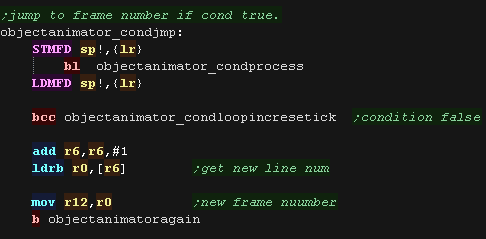 |
| condbra will branch to an alternative frame/tick
based on a condition, This is a relaitve offset to the tick number,
so allows a number of ticks to be 'skipped' and may be more useful
than jump for skipping a few commands. Parameter 1 is the offset in the object data to be tested/ Parameter 2 is the 'comparison value' Parameter 3 is the new offset The top 3 bits of the command byte define the condition. |
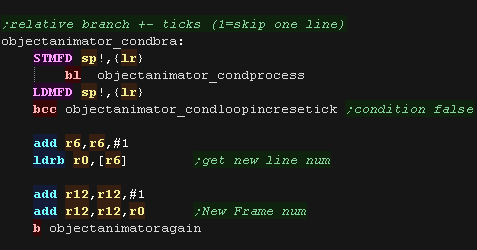 |
| load16 will load a 16 bit value into an offset of
the objects variables. The data is in LITTLE ENDIAN format. This is useful for changing a 16 bit sprite pointer. |
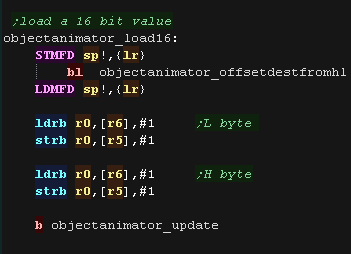 |
| load8 will load an 8 bit value into
an offset of the objects variables. This is useful for changing a Xpos or Ypos |
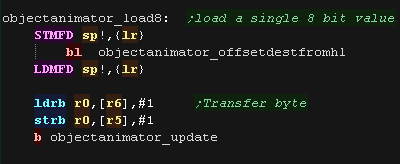 |
| load8dual Sets two separate 8 bit values. The first byte is a pair of offsets (in the object data) - one is defined by the low nibble, the other by the high byte of the nibble. This means only the first 16 bytes of the object data can be changed in this way. |
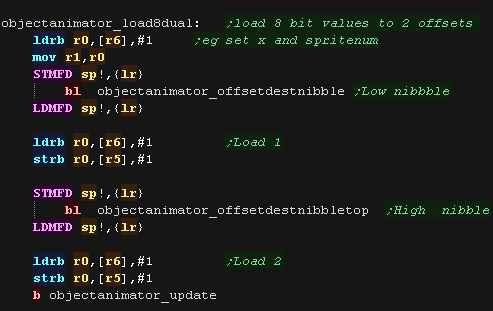 |
| add8dual Adds two separate 8 bit values. The first byte is a pair of offsets (in the object data) - one is defined by the low nibble, the other by the high byte of the nibble. This means only the first 16 bytes of the object data can be changed in this way. |
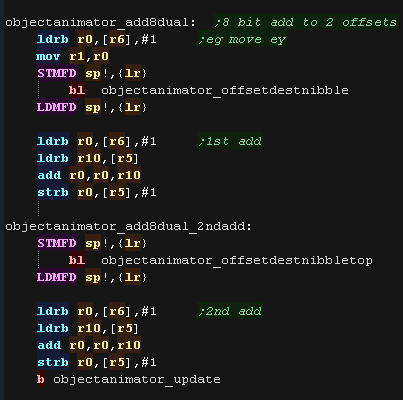 |
| addmasked performs an add and mask operation The first parameter is added to the destination The second parameter is ANDed with the result. By setting the AND mask to a value of #3 it would be possible to cycle between values 0,1,2,3 (maybe for toggling sprite frames) By setting the AND mask to #255, this acts as as simple ADD |
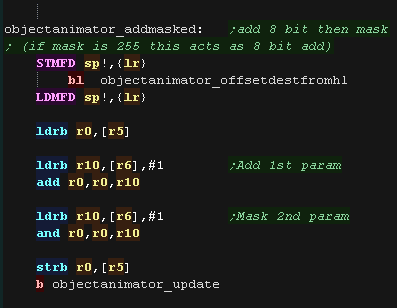 |
| loadadd8dual Loads one 8 bit value to one object
value, and adds another 8 bit value to another object value The first byte is a pair of offsets (in the object data) - one is defined by the low nibble, the other by the high byte of the nibble. |
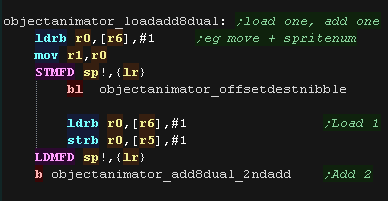 |
| condld8 will load a new 8 bit value to the object
value if the condition is true. Parameter 1 is the offset in the object data to be tested/changed Parameter 2 is the 'comparison value' Parameter 3 is the new value to set if the condition is true. The top 3 bits of the command byte define the condition. |
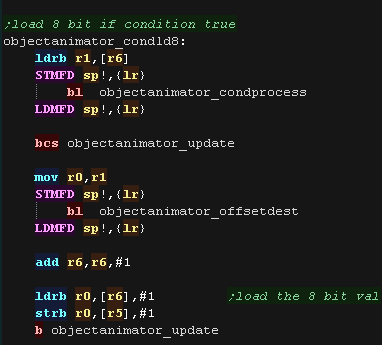
|
| condadd8 will conditionally add an 8
bit value to the object value if the condition is true. Parameter 1 is the offset in the object data to be tested/changed Parameter 2 is the 'comparison value' Parameter 3 is the new value to set if the condition is true. The top 3 bits of the command byte define the condition. |
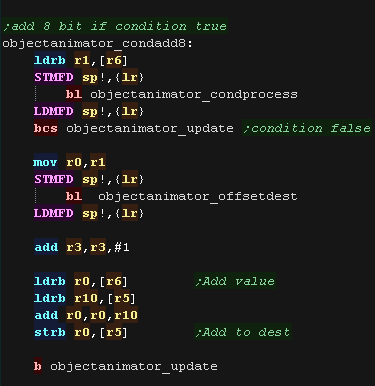 |
| condanim will conditionally switch to a new
animator script (starts from frame 0) Parameter 1 is the offset in the object data to be tested/changed Parameter 2 is the 'comparison value' Parameter 3 is the new animator to set if the condition is true. The top 3 bits of the command byte define the condition. |
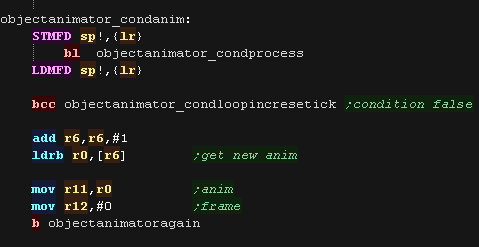 |
Helper routines
| objectanimator_update is executed after the command, Bit 5 of the original command number is tested, this is the 'EXTra line' flag, which allows multiple lines to be processed in a single tick. | 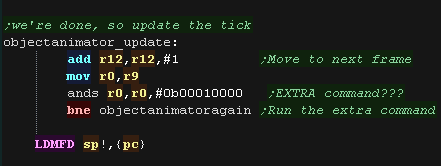 |
| offsetdestnibble routines will set
R5 to the object offsets according to two 4 bit offsets. The top nibble can optionally switch to R8/IY as the source object, based on bit 7 of the command byte (used for conditions on some commands) |
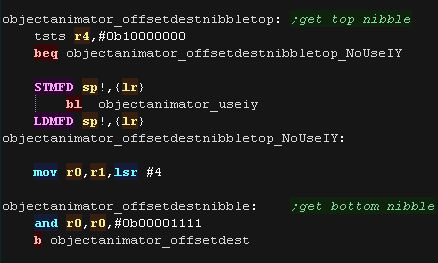 |
| offsetdestfromhl will set R5 to an offset defined
by a single byte. There are two versions, one for conditions (which cannot swap IY) , and one for non-conditions (which can swap IY) |
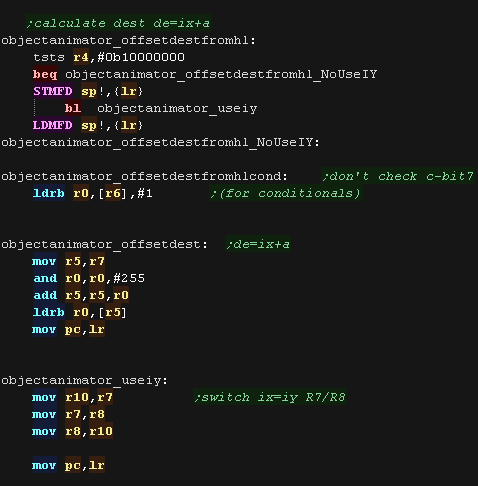 |
| The conditions
take a byte from the object data, and compare it to an immediate
value parameter. One of 8 possible conditions can be tested, decided by the top 3 bits of the command byte. If the condition is true an action will be performed. Here we load the parameters, and branch to the condition processing routines. |
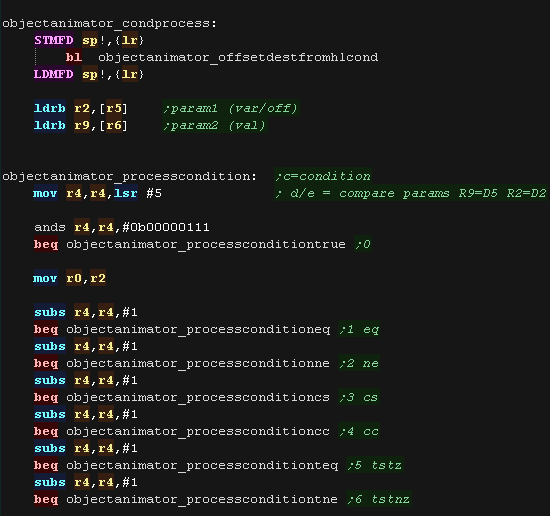 |
| Condition type 7 is a special case, it's ANDed with the world
tick. and is true if the result is zero. This allows events to occur only rarely, for example anding with a value %00000010 would make something happen for two ticks, every two ticks. |
 |
| We perform the required comparison and set the carry flag
according to the result. Note we clear R4 once we're done - it contained the command before, but the top bit is used by some 'non conditional' commands for R7-R8 / IX-IY flip |
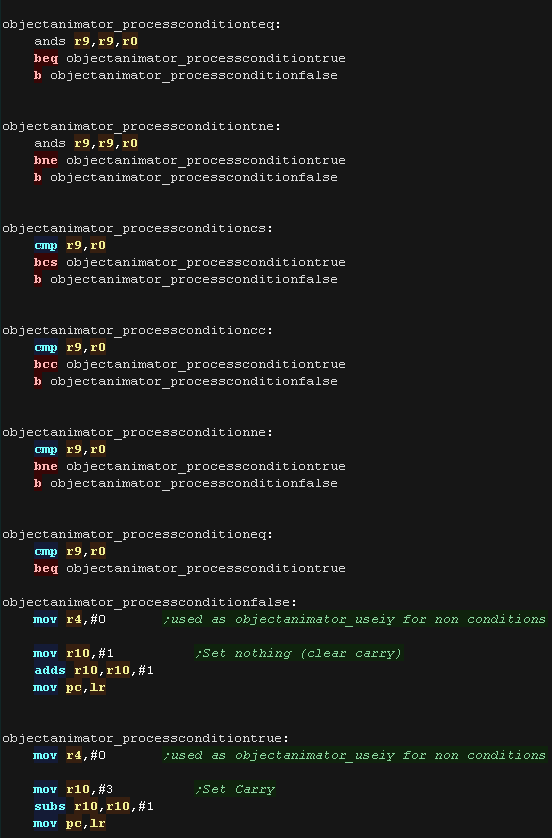 |
| View Options |
| Default Dark |
| Simple (Hide this menu) |
| Print Mode (white background) |
| Top Menu |
| ***Main Menu*** |
| Youtube channel |
| Patreon |
| Introduction to Assembly (Basics for absolute beginners) |
| Amazon Affiliate Link |
| AkuSprite Editor |
| ChibiTracker |
| Dec/Bin/Hex/Oct/Ascii Table |
| Alt Tech |
| Archive.org |
| Bitchute |
| Odysee |
| Rumble |
| DailyMotion |
| Please note: I wlll upload more content to these alt platforms based on the views they bring in |
| 68000 Content |
| ***68000 Tutorial List*** |
| Learn 68000 Assembly |
| Hello World Series |
| Platform Specific Series |
| Simple Samples |
| Grime 68000 |
| 68000 Downloads |
| 68000 Cheatsheet |
| Sources.7z |
| DevTools kit |
| 68000 Platforms |
| Amiga 500 |
| Atari ST |
| Neo Geo |
| Sega Genesis / Mega Drive |
| Sinclair QL |
| X68000 (Sharp x68k) |
| 8086 Content |
| Learn 8086 Assembly |
| Platform Specific Series |
| Hello World Series |
| Simple Samples |
| 8086 Downloads |
| 8086 Cheatsheet |
| Sources.7z |
| DevTools kit |
| 8086 Platforms |
| Wonderswan |
| MsDos |
| ARM Content |
| Learn ARM Assembly |
| Learn ARM Thumb Assembly |
| Platform Specific Series |
| Hello World |
| Simple Samples |
| ARM Downloads |
| ARM Cheatsheet |
| Sources.7z |
| DevTools kit |
| ARM Platforms |
| Gameboy Advance |
| Nintendo DS |
| Risc Os |
| Risc-V Content |
| Learn Risc-V Assembly |
| Risc-V Downloads |
| Risc-V Cheatsheet |
| Sources.7z |
| DevTools kit |
| MIPS Content |
| Learn Risc-V Assembly |
| Platform Specific Series |
| Hello World |
| Simple Samples |
| MIPS Downloads |
| MIPS Cheatsheet |
| Sources.7z |
| DevTools kit |
| MIPS Platforms |
| Playstation |
| N64 |
| PDP-11 Content |
| Learn PDP-11 Assembly |
| Platform Specific Series |
| Simple Samples |
| PDP-11 Downloads |
| PDP-11 Cheatsheet |
| Sources.7z |
| DevTools kit |
| PDP-11 Platforms |
| PDP-11 |
| UKNC |
| TMS9900 Content |
| Learn TMS9900 Assembly |
| Platform Specific Series |
| Hello World |
| TMS9900 Downloads |
| TMS9900 Cheatsheet |
| Sources.7z |
| DevTools kit |
| TMS9900 Platforms |
| Ti 99 |
| 6809 Content |
| Learn 6809 Assembly |
| Learn 6309 Assembly |
| Platform Specific Series |
| Hello World Series |
| Simple Samples |
| 6809 Downloads |
| 6809/6309 Cheatsheet |
| Sources.7z |
| DevTools kit |
| 6809 Platforms |
| Dragon 32/Tandy Coco |
| Fujitsu FM7 |
| TRS-80 Coco 3 |
| Vectrex |
| 65816 Content |
| Learn 65816 Assembly |
| Hello World |
| Simple Samples |
| 65816 Downloads |
| 65816 Cheatsheet |
| Sources.7z |
| DevTools kit |
| 65816 Platforms |
| SNES |
| eZ80 Content |
| Learn eZ80 Assembly |
| Platform Specific Series |
| eZ80 Downloads |
| eZ80 Cheatsheet |
| Sources.7z |
| DevTools kit |
| eZ80 Platforms |
| Ti84 PCE |
| IBM370 Content |
| Learn IBM370 Assembly |
| Simple Samples |
| IBM370 Downloads |
| IBM370 Cheatsheet |
| Sources.7z |
| DevTools kit |
| Super-H Content |
| Learn SH2 Assembly |
| Hello World Series |
| Simple Samples |
| SH2 Downloads |
| SH2 Cheatsheet |
| Sources.7z |
| DevTools kit |
| SH2 Platforms |
| 32x |
| Saturn |
| PowerPC Content |
| Learn PowerPC Assembly |
| Hello World Series |
| Simple Samples |
| PowerPC Downloads |
| PowerPC Cheatsheet |
| Sources.7z |
| DevTools kit |
| PowerPC Platforms |
| Gamecube |
| Work in Progress |
| ChibiAndroids |
| Misc bits |
| Ruby programming |
Buy my Assembly programming book
on Amazon in Print or Kindle!


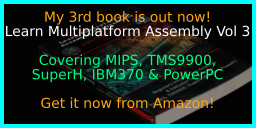
Available worldwide!
Search 'ChibiAkumas' on
your local Amazon website!
Click here for more info!

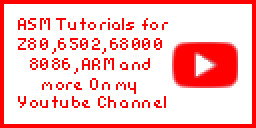
Buy my Assembly programming book
on Amazon in Print or Kindle!



Available worldwide!
Search 'ChibiAkumas' on
your local Amazon website!
Click here for more info!


Buy my Assembly programming book
on Amazon in Print or Kindle!



Available worldwide!
Search 'ChibiAkumas' on
your local Amazon website!
Click here for more info!




